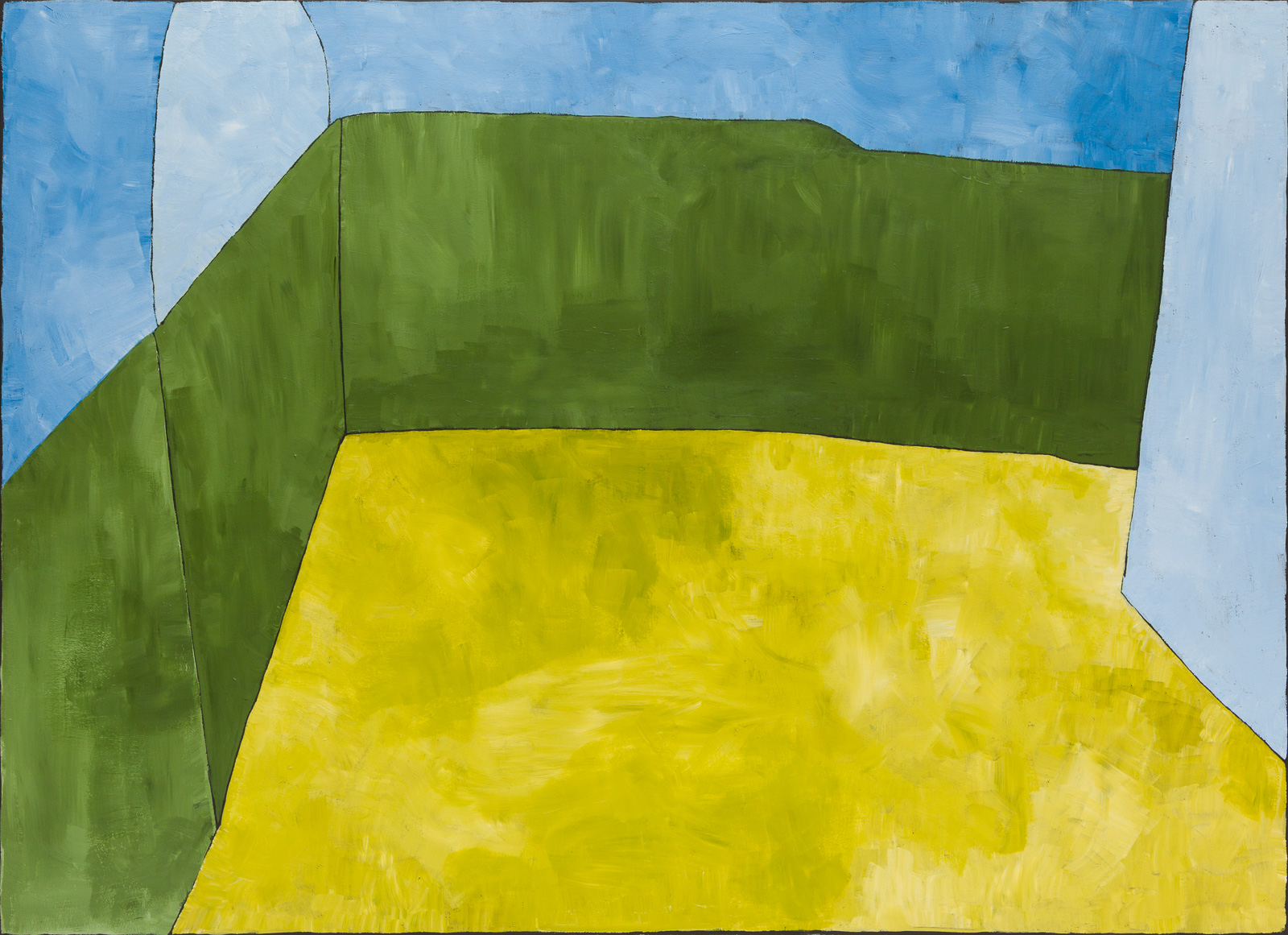1919 Salon
Galerie pompom, Sydney, 12 June - 7 July 2019
Laura Badertscher, Emma Borland, Jess Bradford, Billy Bob Coulthurst, Bridget Stehli Curnow, Rod Denson, Scott Duncan, Ricky Emmerton, Hayley Megan French, Emily Galicek, Elsiena ten Kate, Tanya Linney, Rob McHaffie, Heidi Melamed, Adam Norton, Emanuel Rodriguez-Chaves, David Rosado, Hugh Van Schaick, Tom Yousif.
Curated by George Adams
7th sketch of my backyard, 2018, acrylic on paper
1919 at Galerie pompom
Hayley Megan French
The parameters of 1919 establish a physical experience of the network of painting as a mode of thought. When we step into the gallery, we are immediately halted, presented with what Rhana Devenport describes as ‘the intimacies, urgencies, awkwardness and unbounded possibilities of painting.’[i]
The connections between the 19 exhibiting artists are broad—most are working in Australia today, with a few exceptions. The exhibition itself is one in a long tradition of MOP Projects, now Galerie pompom, showcasing current painting practices. Within this group, 7 of the exhibiting artists were selected by curator George Adams from the National Art School’s 2018 Graduate Exhibitions, continuing a history of supporting emerging painting.
1919 features works by Sydney-based artists: Jess Bradford, Bridget Stehli Curnow, Rod Denson, Scott Duncan, Hayley Megan French, Emily Galicek, Elsiena ten Kate, Tanya Linney, Heidi Melamed, Adam Norton, Hugh Van Schaick and Tom Yousif; Melbourne-based artists: Emma Borland, Billy Bob Coulthurst, Rob McHaffie and Emanuel Rodriguez-Chaves; Townsville-based: Ricky Emmerton; alongside Laura Badertscher who works across Sydney and Zurich and Portugal-based David Rosado.
With multiple works included from each artist, the gallery holds within it a network of ideas—one which continually informs our experience of every painting in the room. And yet within this visual discord, the works still create their own spaces of pause, of intimacy. Justin Paton writes of this experience with painting, ‘when you come as close to the painting as the painter stood to make it, it is for you and you only.’[ii] For Paton, this is a radical intimacy—a particular power of painting to bring us into the present. And beyond this moment of intimacy and presentness, painting has an inherent slowness. Whether in the moment of experiencing the work, or much later, the edges of the paintings reach out to meet us, quietly infiltrating the way we are thinking, the way we are interacting.
While many of the works exist within the 2-dimensional painting frame, others are derived from it. The artists’ approaches are many and varied, reflective of the theoretical and expanded project of painting post-Conceptual Art. Painting now can be understood as a mode of thought, as unbounded relationships and possibilities (possibilities of different spaces and times). The experience of painting then, reminds us that there are other ways of being and seeing [iii] that are different to our own.
Many of these artists were born, or have lived and worked outside of Australia, bringing these experiences and influences together in this room. The physical presentation of 1919 ensures we experience this content as an affective network, moving us sideways in motion, sometimes backwards and forwards: between human relationships; between material, technological, spatial and temporal relationships created through the works. Each work is connected both to itself and to what it adjoins, making meaning through physical proximity. So how then does each painting change the way we read the painting beside it? Where does one painting finish and the other begin?
Michael Baxandall has written on this idea of artistic influence and how it informs an understanding of our context. The way artists actively re-read other artists and traditions through their own context, he argues, emphasises the importance of linking questions of this re-reading with questions of the ‘artistic, social, and cultural contexts in which authorial selections of influence are performed.’[iv]
In this space then, there are many lines to draw, many relationships to follow and unpack as you move through the space. Here is an embodied experience of the network of painting ideas and influence—as we move between the works, pause, and then move again, the network rearranged.
[i] Rhana Devenport, Necessary Distraction: A Painting Show, Auckland Art Gallery Toi o Tamaki, 2016, 25.
[ii] Justin Paton, Necessity and glut: notes of painting, “Painting. More Painting,” Australian Centre for Contemporary Art, 2016, 18-21.
[iii] ibid.
[iv] Michael Baxandall, Patterns of Intention: On the Historical Explanations of Pictures, New Haven and London: Yale University Press, 1986, 58-59.
1919 Salon, installation view, Galerie pompom, Sydney. Photo: Docqment
Being at home (II), 2019, acrylic on canvas, 122.5 x 168cm. Photo by Docqment
familiar and strange, 2019, acrylic on canvas, 81 x 122cm. Photo by Docqment



